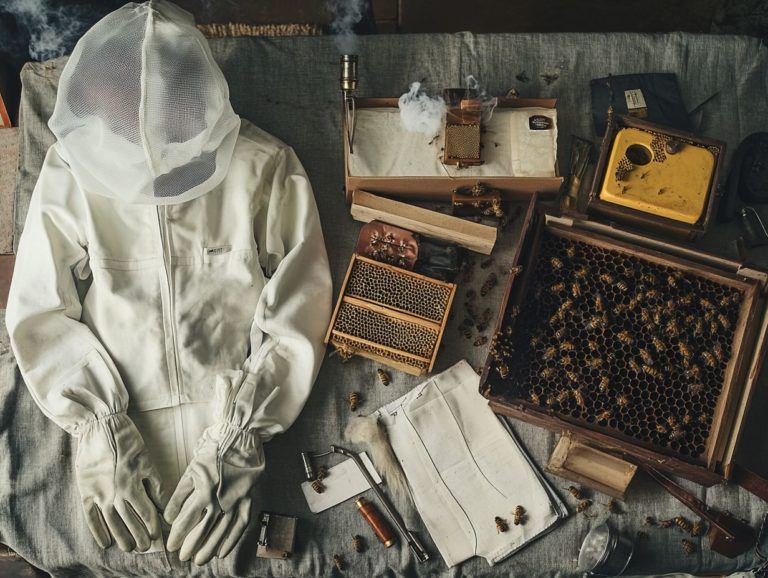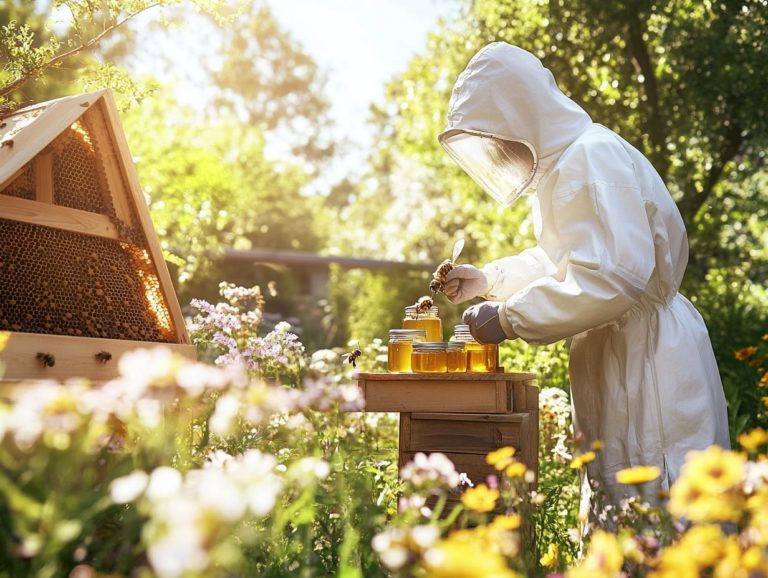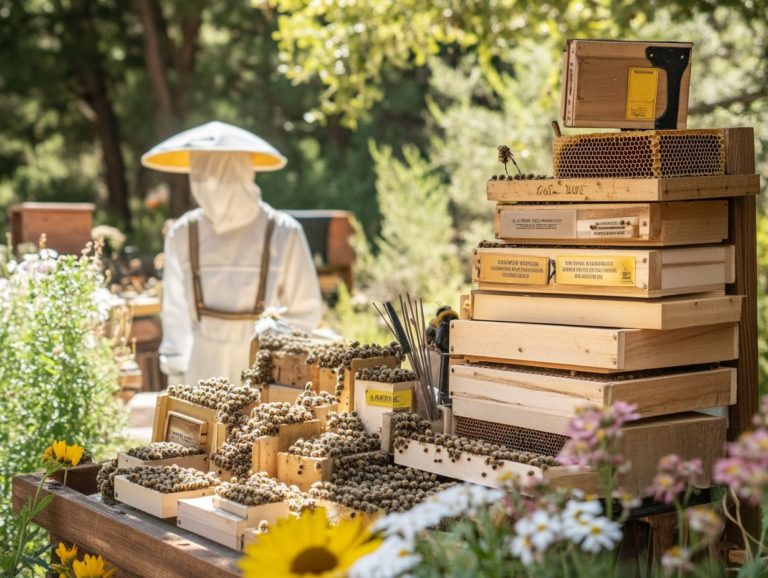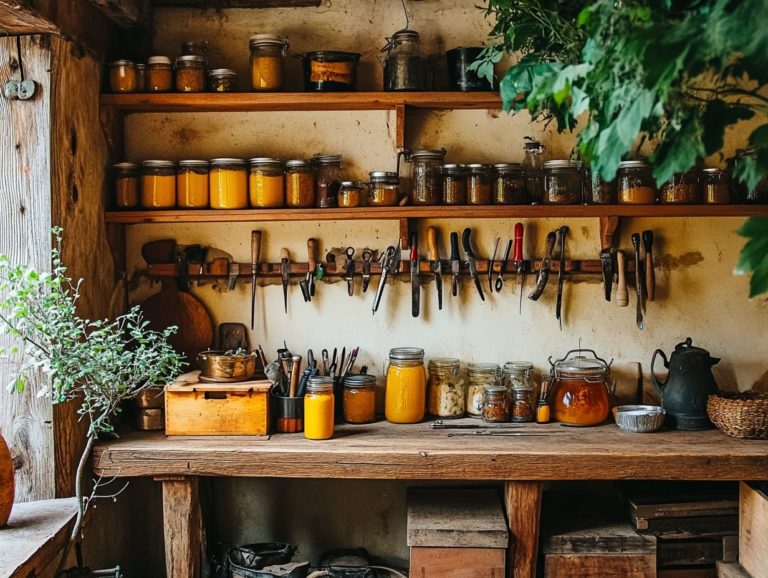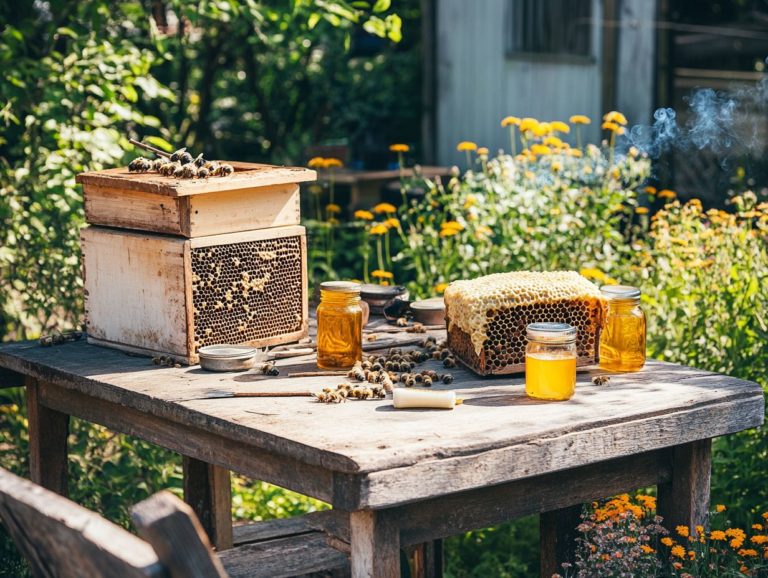How to Choose Durable Beekeeping Supplies
Embarking on the journey of beekeeping is an exhilarating and rewarding experience, but your success largely depends on having the right beekeeping supplies at your disposal.
From essential hive components like the Langstroth hive to protective gear and specialized tools such as the smoker tool, every item is crucial in ensuring a smooth and safe beekeeping experience. This article delves into the must-have supplies for beekeeping, guiding you on how to select quality materials while sharing valuable tips for maintaining safety and durability.
Contents
- Key Takeaways:
- What Are the Essential Beekeeping Supplies?
- How to Choose Quality Hive Components?
- What to Look for in Protective Gear?
- Which Beekeeping Tools Are Necessary?
- How to Ensure Safety and Durability in Beekeeping Supplies?
- Frequently Asked Questions
- What are some key factors to consider when choosing durable beekeeping supplies?
- How do I know if the beekeeping supplies I am considering are made of durable materials?
- What are some durable options for beekeeping protective gear?
- Are there any specific brands known for producing durable beekeeping supplies?
- How can I ensure that my beekeeping equipment will last for many seasons?
- Should I invest in more expensive beekeeping supplies for better durability?
Key Takeaways:
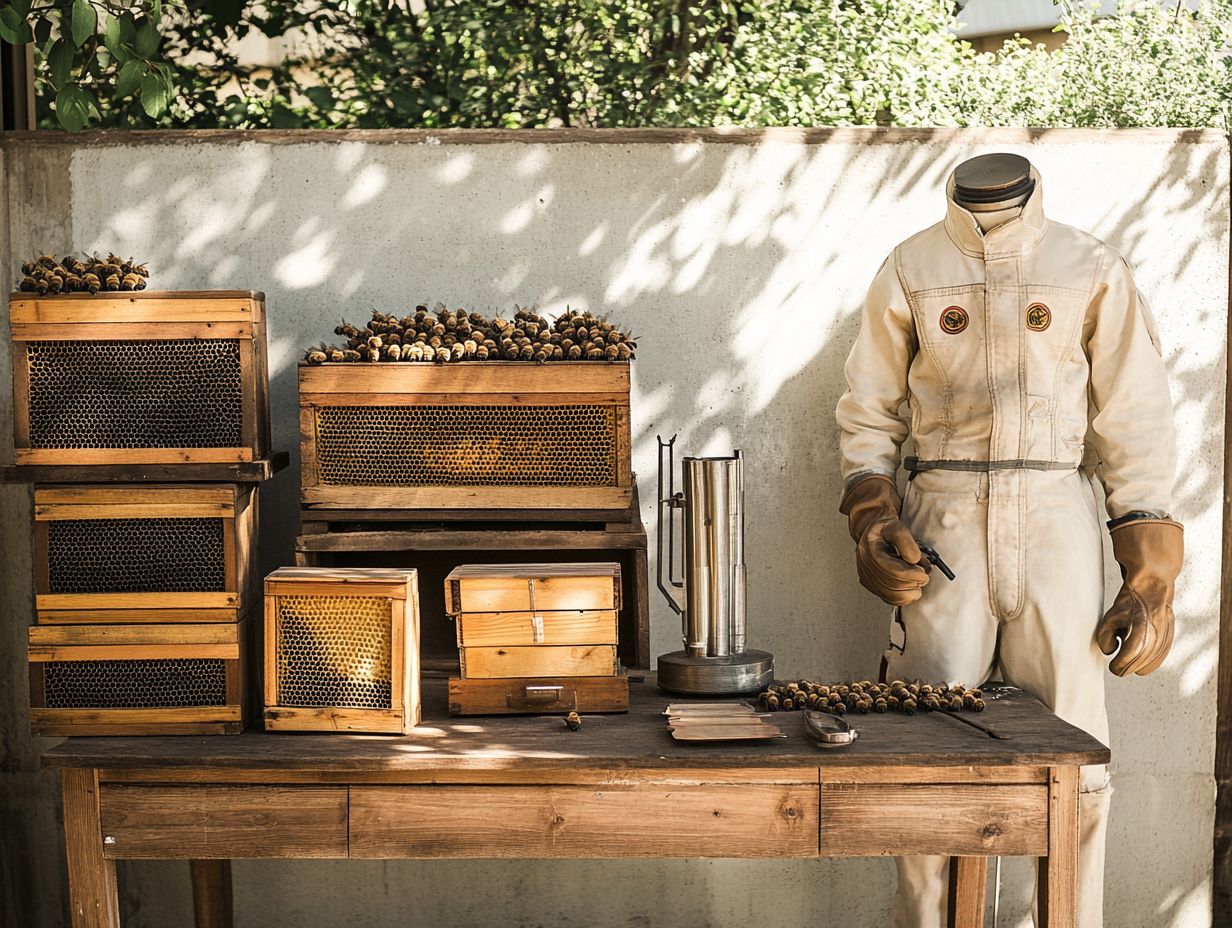
- Opt for beekeeping supplies made from durable materials such as stainless steel and high-quality wood, as they will last longer and withstand the demands of beekeeping.
- Ensure a proper fit and comfort when choosing protective gear, as uncomfortable suits can hinder movement and increase the risk of bee stings.
- Invest in quality brands and consult with experienced beekeepers like Adam Martin, an American apiarist, to ensure safety and durability in your beekeeping supplies.
What Are the Essential Beekeeping Supplies?
Beekeeping is a truly rewarding endeavor that requires an array of essential supplies for successful honey production and effective colony management. From the foundational components of hive equipment such as hive bodies to protective gear designed to keep you safe, understanding these vital beekeeping supplies is crucial, whether you’re just starting out or you have years of experience under your belt.
Key items you ll want to consider include:
- Langstroth hives
- hive bodies
- frames
- smoker
- queen excluder
Having the right beekeeping supplies boosts your honey yield and keeps your bee colonies healthy and thriving!
1. Hive Components
The cornerstone of successful beekeeping lies in your understanding of the essential hive components, which include various pieces of equipment designed to house and support your bee colonies.
A typical Langstroth hive consists of hive bodies that serve as the main structure for your bees, having hive frames that hold the beeswax foundation where they build their comb. Choose high-quality materials for these components, as they directly influence both honey yield and the health of your colony.
Each hive body is a pivotal unit for your bee colonies, providing ample space for brood rearing and honey storage. The frames make it easy for you to inspect the health of the colony, monitor for pests and bee diseases, and harvest honey when the time is right. A well-maintained hive promotes efficient foraging and enhances the overall productivity of honey yield, ensuring that your colonies thrive throughout the seasons.
Investing in durable hive components offers numerous benefits, contributing not only to a stable environment for your bees but also optimizing your experience as a beekeeper. This leads to more rewarding honey harvesting seasons, making all your efforts worthwhile.
2. Protective Gear
Investing in high-quality protective gear is essential for you as a beekeeper if you want to ensure your safety while working with bee colonies. After all, bees can be unpredictable and fiercely protective of their hives.
Your protective gear typically includes bee suits, gloves, and veils designed to shield you from stings, offering you peace of mind during hive inspections and honey extraction. Sourcing this equipment from reputable bee suppliers is crucial; it guarantees durability and reliability, allowing you to focus on your craft without the nagging worry of personal safety.
When selecting your protective gear, it s important to pay attention to the materials used, as they can significantly impact both comfort and fit. Lightweight and breathable fabrics are often the best choices because they help regulate your body temperature on those sweltering days, all while providing adequate protection.
You should also take a moment to evaluate the fit of your suits and gloves to prevent any gaps where bees might sneak in. This will help avoid unpleasant stings. Comfort matters, especially when you re tending to your hives for extended periods.
Prioritize quality and comfort for a safer, more enjoyable beekeeping experience.
3. Beekeeping Tools
Beekeeping tools are essential for maintaining the health of your colonies and helping with honey production, with each tool serving a distinct purpose in hive management. You’ll find that essential equipment includes hive tools for lifting frames, a smoker to calm the bees during inspections, and queen excluders to keep the queen from laying eggs in your honey supers.
By using these tools effectively, you can create a productive and harmonious environment in your hives. A honey extractor is also a must-have, as it uses centrifugal force, which means it spins the frames quickly to efficiently remove honey from the comb, making your harvesting process smooth and effective.
Feeders also play a vital role for your colonies, particularly during times when nectar is scarce. They provide supplemental food that helps sustain the hive.
Each tool contributes significantly to ensuring that your bees remain healthy and productive, directly influencing the success of your honey production and overall colony management.
How to Choose Quality Hive Components?
Selecting quality hive components is essential for maintaining the health and productivity of your bee colonies. The materials, size, and design you choose have a direct impact on the efficiency of honey production and effective colony management.
As you evaluate your options, consider the range of materials available, from traditional wood to modern synthetic choices, and weigh their durability and insulation properties. Hive design is also crucial; it should cater to the needs of your bees while also providing you with convenient access during inspections and honey extraction.
Make informed decisions to create an optimal environment for your bees and streamline your beekeeping experience.
1. Material
The materials you choose for your hive components play a crucial role in determining both their longevity and the comfort of your bee colonies, so it s essential to select wisely. Common choices include wood, like pine or cedar, which are prized for their natural insulation properties, alongside synthetic options that offer impressive durability and pest resistance.
When constructing frames, it s vital that the material adequately supports the beeswax foundation, enabling your bees to build comb effectively and produce honey.
Wooden hives certainly provide a classic aesthetic and facilitate natural ventilation, but they often require regular maintenance to stave off rot. In contrast, plastic hive components boast greater resilience against weathering and pests, though they can lead to fluctuating temperature levels that may not be ideal for the bees development.
Additionally, always ensure proper frame construction to maintain colony health. Understanding how each material impacts your bees environment can transform your beekeeping experience.
2. Size and Design
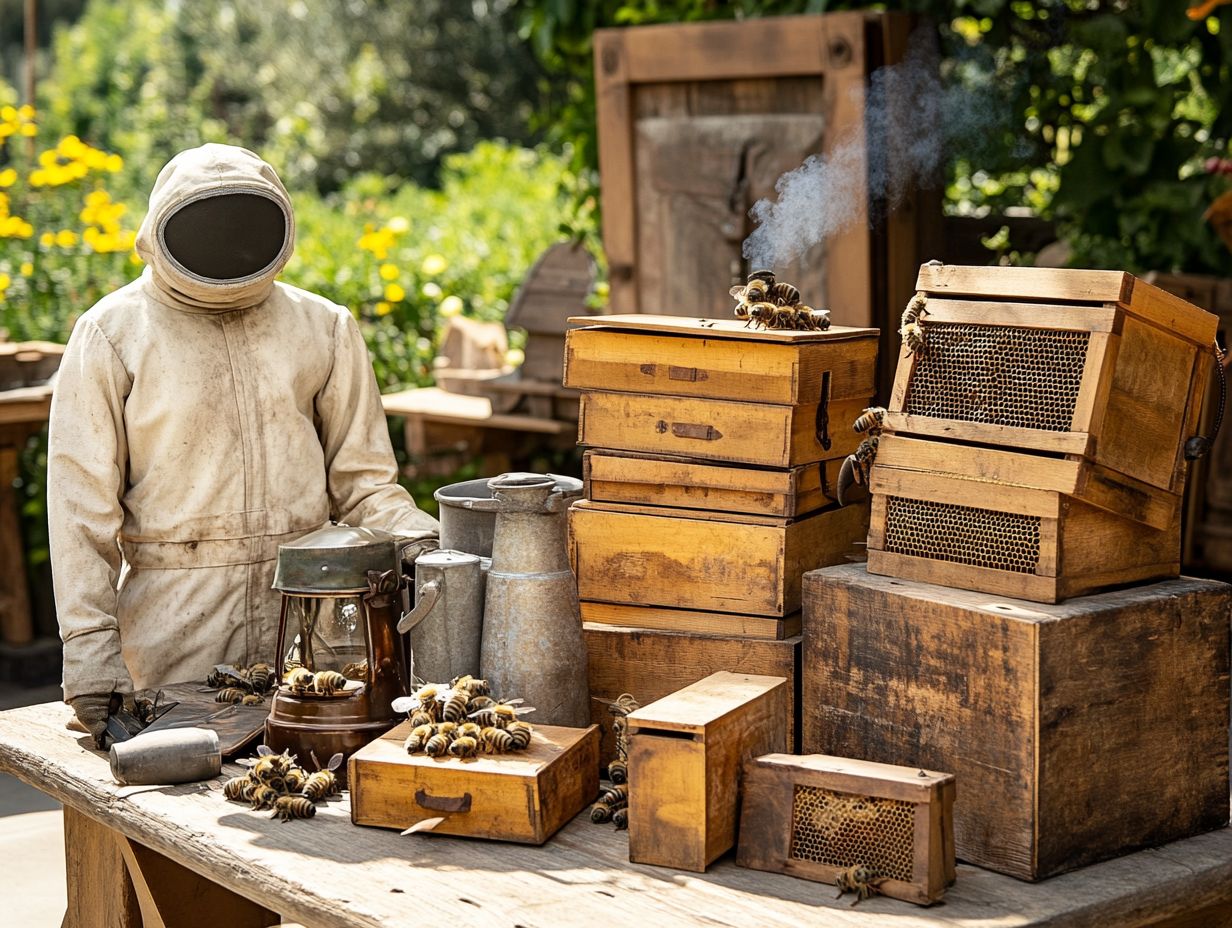
The size and design of your hive components are important factors that directly influence how you manage your bee colonies and the levels of honey production you achieve. Take, for instance, the standard Langstroth hive a commonly used beehive design that provides generous space for bees to flourish. Honey supers are specifically crafted to optimize honey storage without cramping the bees’ style.
Understanding the right dimensions and configurations for hive bodies and supers is essential for effective colony management and successful honey extraction. The dimensions of your hive components significantly impact the natural behaviors of your bees, such as swarming and foraging.
A well-designed hive fosters a seamless workflow, allowing your bees to navigate effortlessly and reducing their stress levels. If your hives are poorly sized, you may encounter congestion, which can hinder the productivity of your colony.
The materials you choose for hive construction can also affect temperature regulation and humidity levels, both of which are crucial for maintaining a healthy environment for your bees. By prioritizing thoughtful sizes and designs, you can enhance the well-being of your colonies.
This ultimately leads to more abundant honey yields and a thriving ecosystem. Consider the advice of a French botanist when selecting plants to enhance your beekeeping environment.
3. Assembly and Durability
When you re considering the longevity and consistent honey production of your hives, the ease of assembly and durability of the components should be at the forefront of your mind. Setting up your hives can be quick and fun with high-quality parts designed for easy assembly!
With durable materials that can withstand the elements and ward off pests, you ll ensure that your hive remains intact over time, providing a stable environment for your colonies.
As you select hive components, prioritize those made from robust materials like cedar or Baltic birch plywood. These options resist warping and cracking while offering protection against various environmental stressors.
Exploring pre-drilled components is also wise, as they simplify the assembly process, cut down installation time, and minimize the chances of errors. Don’t forget to consider Langstroth hives and hive frames, the wooden structures that hold the honeycomb inside a beehive, as these are popular choices among experienced beekeepers.
Regular maintenance checks are crucial inspect those joints and seals. This proactive approach goes a long way in preserving the integrity of your hive, ultimately safeguarding the health of your bee population.
By fostering a thriving ecosystem for honey production and pollination, you can significantly enhance your beekeeping efforts.
What to Look for in Protective Gear?
When choosing protective gear for beekeeping, prioritize reliable equipment that ensures both safety and comfort during hive inspections and honey extraction.
The choice between a full bee suit and a more minimalist jacket can greatly influence your level of protection against bee stings. The quality of the materials and construction of your protective gear is essential for ensuring durability and effectiveness.
Be sure to source your beekeeping supplies from reputable bee suppliers to ensure you are getting high-quality gear. Comfort and fit are also crucial, as they allow for the agility and ease of movement necessary when managing your bee colonies.
1. Type of Suit
Whether you opt for a traditional full body suit or something more minimalist, consulting the expertise of an American apiarist can help guide your decision.
The choice of suit you select as part of your protective gear can significantly impact your comfort and safety while handling bees. Full bee suits provide comprehensive protection, while lighter jackets may be more suitable for warmer weather or less intense hive management.
Don’t overlook the importance of gloves and veils; these essential components of your protective gear ensure you remain shielded from stings while maintaining visibility and dexterity during hive inspections.
When selecting the right protective suit, carefully assess the various options available on the market, as each comes with its unique advantages and drawbacks. For example, you might consider ventilated suits to stay cool during sweltering summer days, but keep in mind that they may not offer the same level of sting protection as traditional suits.
Alternatively, while disposable suits provide convenience and ease of use, they lack durability and proper insulation. Other essential items include a queen excluder and honey supers, which are vital for efficient hive management.
Understanding the specific requirements of your environment and the level of bee activity is essential. This knowledge will enable you to make an informed choice, ultimately enhancing your safety and comfort during hive management.
Learning from experienced beekeepers can provide valuable insights into effective colony management and beekeeping methods.
2. Material and Quality
The material and quality of your protective gear are paramount for both effectiveness and longevity. Choose wisely when selecting your equipment. Many experienced beekeepers recommend using strong materials that resist bee stings or beeswax foundation for added protection and durability.
Choosing the right materials can make a world of difference in your beekeeping adventures! Consider options like kevlar-reinforced fabrics, which provide robust protection against aggressive stings, while moisture-wicking materials improve breathability, helping you stay cool and dry.
Equally important are the construction and fit of the gear; if it doesn t fit properly, it could hinder your mobility or leave gaps in your protection. Therefore, prioritizing high-quality protective gear that meets specific performance standards is crucial, ensuring you can work efficiently and safely in your hives.
Investing in gear with flexible seams and adjustable features enhances comfort and mobility.
3. Comfort and Fit
Comfort and fit are paramount for effective hive management. A well-fitted suit grants you the freedom to move while significantly reducing the chances of bees finding their way through any gaps or openings.
Opting for comfortable materials helps diminish fatigue and irritation, allowing you to work longer and more efficiently with your colonies during honey production and hive maintenance.
Choosing breathable fabrics helps manage heat, especially during intense periods of honey extraction. Selecting the right size is essential; consult sizing charts and consider the layers of clothing you’ll wear to achieve an optimal fit.
Breathable cotton or specialized synthetic blends strike the perfect balance between protection and comfort, preventing overheating while offering a reliable barrier against stings.
Choosing gear with flexible seams and adjustable features enhances your mobility and overall comfort.
When you prioritize these factors, you not only bolster your personal safety but also create a more effective and enjoyable beekeeping experience.
Consult with an experienced beekeeper today to find the best suit for your needs!
Which Beekeeping Tools Are Necessary?
As an aspiring beekeeper, learning from renowned individuals like Adam Martin and Bee Kept in Tennessee can provide you with invaluable insights into the best beekeeping methods and tools to use.
Essential beekeeping tools are vital for managing your bee colonies and ensuring successful honey extraction, making them critical for any serious beekeeper.
Among these tools, the smoker helps you calm the bees during hive inspections. The hive tool is perfect for lifting frames and separating boxes, granting you easy access to your buzzing friends. Don’t forget the importance of using a hive stand and bottom board to support and elevate your hives for better ventilation and easier access.
A bee brush is essential for gently removing bees from frames without causing any harm. This allows you to carry out your work with the utmost care and precision.
Essential Tool 1: The Smoker
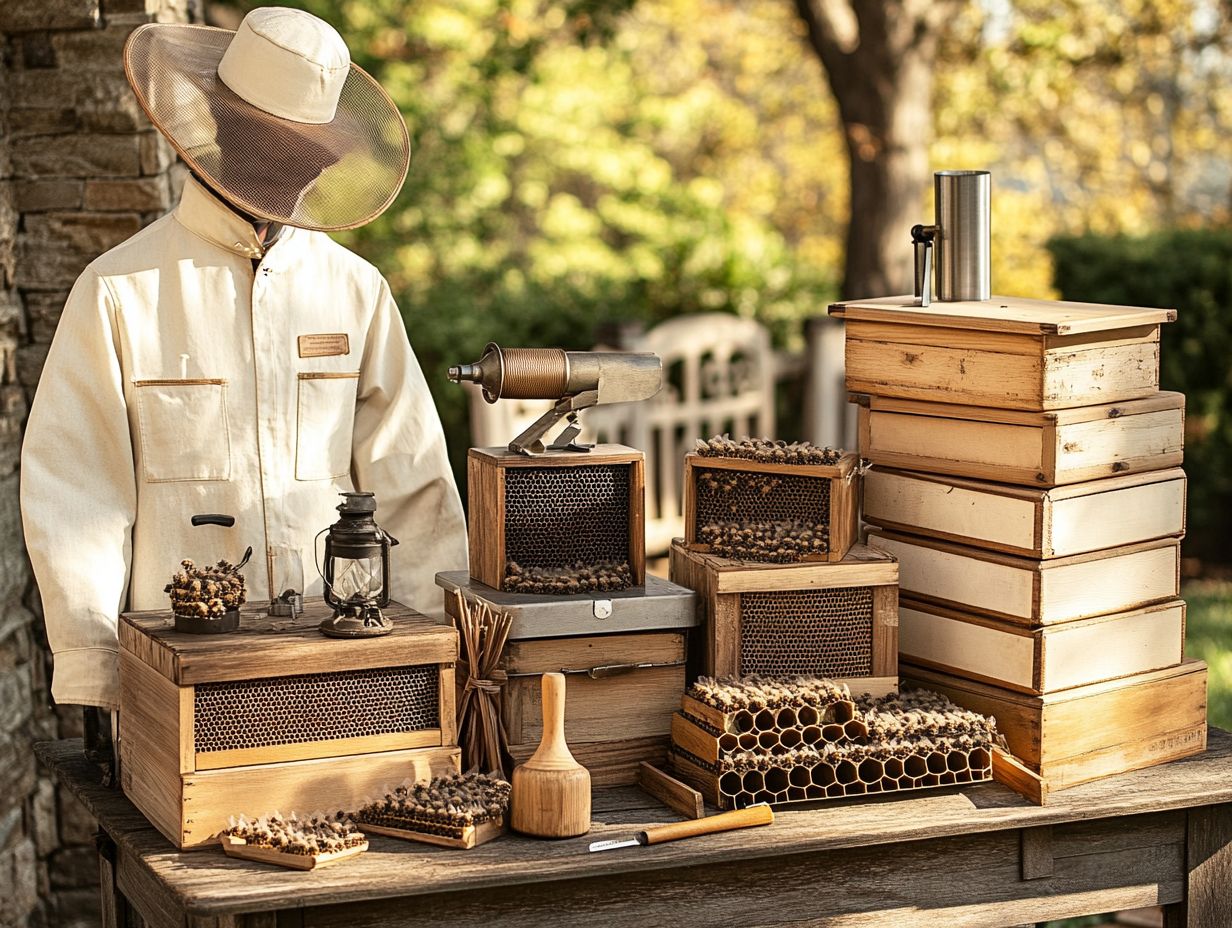
Invented by a French botanist, the smoker remains indispensable for beekeepers globally. It is one of your most vital beekeeping tools, offering a reliable means to calm your bees during inspections and hive management.
By producing cool smoke, the smoker cleverly masks the warning signals released by the bees, which diminishes their defensive behavior. This helps you work safely and easily, particularly during honey extraction and hive maintenance tasks.
Understanding how the smoker operates is key to mastering effective hive management. Typically filled with materials like pine needles or burlap, it generates smoke upon ignition, creating a soothing effect on your bees, enhancing your ability to observe and manage the hive effectively.
For optimal results, employing best practices in using the smoker is crucial. This involves lighting it correctly, maintaining a steady flow of smoke, and using it judiciously to avoid overwhelming the bees. By adhering to these techniques, you can significantly elevate the efficiency of your hive inspections, fostering a healthier environment for both you and your bees.
Essential Tool 2: The Hive Tool
The hive tool is a must-have for every beekeeper! It serves various functions during hive inspections and maintenance. This versatile instrument is your go-to for prying apart hive boxes, lifting frames, and scraping away excess propolis or wax.
Mastering the hive tool is vital for effective frame construction and overall management of your hive. Additionally, tools like the comb and beeswax foundation are essential for maintaining hive structure and health.
Beyond its practical uses, the hive tool promotes the health of your bee colonies. By keeping the hives clean and well-maintained, it helps ward off diseases and pests that can disrupt the delicate balance within the colony. Efficient inspections with your hive tool can lead to improved honey production, as you’ll be able to evaluate your bees’ progress and take timely action when needed.
The hive tool is not merely a necessity; it is a pivotal instrument in your journey toward successful beekeeping, enhancing both the welfare of your bees and the quality of the honey you harvest. Don’t wait! Get your beekeeping tools today to start your journey!
3. Bee Brush
The bee brush is a gentle yet highly effective tool at your disposal, perfect for safely moving bees from frames and other surfaces during your hive inspections. With its soft bristles crafted to minimize harm, this tool enables you to handle bees with care. By adding a bee brush to your tools, you ensure a harmonious interaction with your bee colonies. This tool, along with other essential beekeeping supplies, can be sourced from specialized bee suppliers.
As you effectively clear away bees without squashing or stressing them, the bee brush plays a pivotal role in keeping your hive healthy. During inspections where time is often of the essence maintaining a calm environment is paramount to prevent alarm within the colony. This tool not only facilitates the examination of vital hive components but also encourages the bees’ natural behaviors, allowing them to remain undisturbed during necessary checks.
Ultimately, the bee brush enhances your ability to manage hives attentively, significantly contributing to productive beekeeping practices and fostering a thriving ecosystem.
How to Ensure Safety and Durability in Beekeeping Supplies?
Ensuring the safety and durability of your beekeeping supplies is crucial for effective hive management and the wellbeing of both you and your bee colonies. Proper storage of your tools and protective gear is essential to extend their lifespan and maintain functionality. Investing in quality brands renowned for their durability can prevent the need for frequent replacements. Tools like the smoker and hive tools are indispensable for any beekeeper.
Consulting seasoned beekeepers provides invaluable insights into best practices for maintaining your equipment and ensuring safety during hive inspections. Engaging in sustainable beekeeping practices can also contribute to the long-term health of your bee colonies and the environment.
1. Proper Storage and Maintenance
Proper storage and maintenance of your beekeeping supplies and hive equipment are essential for ensuring their longevity and functionality, allowing you to work efficiently and safely. It s important to clean your tools and store them in a cool, dry place, away from any pesky intruders. Don’t forget to regularly inspect your protective gear and hive bodies for any signs of wear and tear. By establishing a routine maintenance schedule, you can keep your equipment in good shape.
Cleaning your tools is important. Also, using specific storage methods helps preserve your hive tools, smokers, and feed containers. For example, organize your hive components systematically in a well-ventilated shed or barn that shields them from direct sunlight. Always clean and empty your smokers after each use to prevent any buildup, and be sure to inspect honey supers and hive frames for damage before storing them away. Using a queen excluder a device used to keep the queen bee in one area of the hive can help in effective colony management.
Regularly checking for rust or decay on your metal tools will help maintain their integrity. By following these maintenance routines, you not only ensure effective hive management but also boost the overall productivity and health of your bee colonies.
2. Quality Brands and Reviews
Adam Martin, a well-known beekeeper, often advocates for investing in quality beekeeping supplies for better outcomes. Engaging with reputable bee suppliers is key to maintaining Langstroth hives and other hive equipment.
Choosing high-quality brands for your beekeeping supplies can greatly enhance the safety and effectiveness of your hive management. It s essential to research products thoroughly, especially when considering equipment for honey extraction and pollen collection.
In the realm of beekeeping, where the well-being of both your bees and yourself is paramount, selecting the right supplies goes beyond just preference; it becomes a matter of ensuring reliability and resilience. User reviews provide an unfiltered glimpse into how specific brands perform under real-world conditions, helping you discern which products consistently yield superior results. For instance, brands like Bee Kept and others in Tennessee receive high praise in reviews.
This feedback loop fosters a sense of trust, as seasoned beekeepers share their insights on the longevity and practicality of various tools like hive stands and bottom boards. By tapping into these reviews, you can skillfully navigate the vast array of options available, ultimately investing in supplies that guarantee safety, performance, and durability.
This approach leads to thriving hives and an exciting beekeeping journey! Using a Langstroth hive or Layens hive can be a great choice based on your beekeeping methods.
3. Consulting with Experienced Beekeepers
Experienced beekeepers can offer invaluable insights and strategies to ensure the safety and longevity of your beekeeping supplies. These seasoned individuals possess firsthand experience with various tools and equipment, such as beeswax foundation and comb, enabling them to recommend best practices that enhance the durability of your supplies while ensuring effective hive management.
They often share techniques that you won t find in textbooks, offering practical advice that enables you to handle bees with greater confidence and care. This network of hobbyists and professionals can introduce you to essential maintenance routines that keep your hives healthy and thriving. They may also provide guidance on how to deal with bee diseases and emphasize the importance of sustainable beekeeping practices.
By embracing these community resources, you gain access to a treasure trove of knowledge on seasonal management, pest control measures, and the significance of using high-quality materials. Ultimately, tapping into the wisdom of seasoned beekeepers not only optimizes your own practices but also contributes to the overall stability and success of local beekeeping initiatives. Understanding frame construction and the use of foundation can also be pivotal in ensuring effective hive management.
Frequently Asked Questions
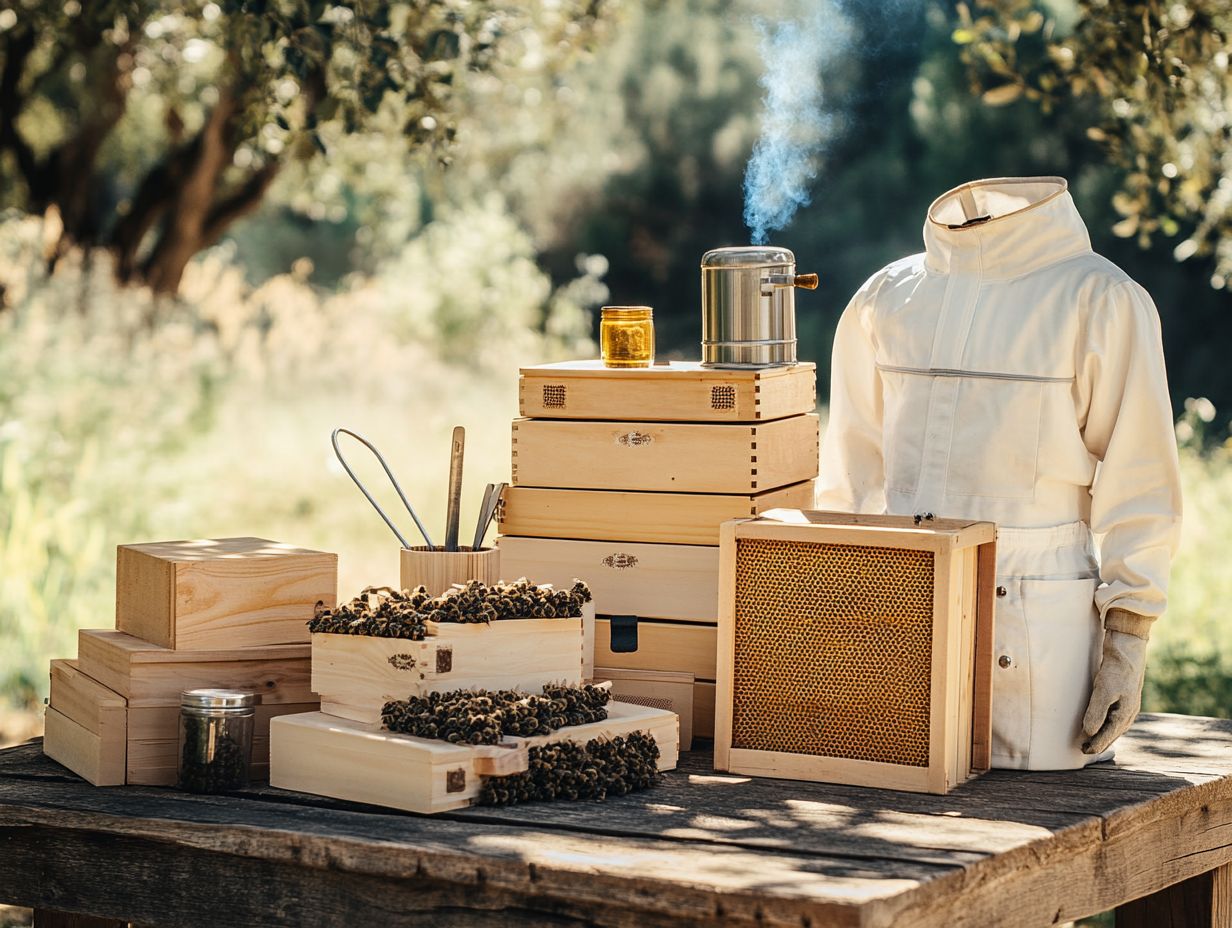
What are some key factors to consider when choosing durable beekeeping supplies?
Key factors to consider when choosing durable beekeeping supplies include material quality and brand reputation!
How do I know if the beekeeping supplies I am considering are made of durable materials?
Checking the materials used, such as stainless steel for tools and beeswax for foundation, is crucial. Look for beekeeping supplies made of high-quality materials such as stainless steel, durable plastics, or weather-resistant wood. It’s also a good idea to research the materials used by the brand and read customer reviews for feedback on durability. Brands like Bee Kept or those recommended by experienced beekeepers like Adam Martin can be good starting points.
What are some durable options for beekeeping protective gear?
Durable beekeeping protective gear includes full-body suits made from heavy-duty cotton or polyester. You ll also want sturdy leather gloves and veils made of tightly woven mesh.
Are there any specific brands known for producing durable beekeeping supplies?
Yes! Brands like Mann Lake, Little Giant, and Brushy Mountain Bee Farm are known for their quality. Always research and compare brands before buying.
How can I ensure that my beekeeping equipment will last for many seasons?
Regularly inspect and store your equipment properly. Keeping items like smoker tools, which help calm bees during inspections, and protective gear in good condition is essential.
Also, keeping your gear clean and well-maintained helps extend its lifespan. Store your supplies in a cool, dry place when not in use.
Should I invest in more expensive beekeeping supplies for better durability?
Investing in high-quality supplies can pay off big time for your beekeeping journey! While higher prices don t always mean better durability, quality gear often lasts longer. Consider your budget and seek recommendations from experienced beekeepers.

